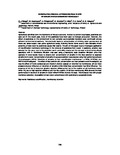| dc.description.abstract | Agricultural activities form the backborne of Kenya´s economy. Inorder to control crop losses, pesticides are
used and in the recent past, more of the pesticides have been used to increase production. However, the
effect of pesticides on the environment is very complex as undesirable transfers occur continually among
different environmental sections. This eventually leads to contamination of drinking water sources such as
rivers and lakes located near active agriculture areas, including flower farms around Lake Naivasha where
poisoning of lake water by pesticides caused fish deaths. The aim of this paper was to investigate application
of nanofiltration membrane technology in the removal of pesticides from water. A pesticide, atrazine was
selected for the study due to its extensive use in controlling weeds and the adverse environmental effects
associated with it. Membrane filtration was used using a laboratory scale crossflow filtration units that
operated in total recycle mode to ensure even concentration of atrazine in the feed solution to seperate
atrazine form water. Concentration of atrazine in aqueous solution was analyzed using high performance liquid
chromatography (HPLC). Retention of atrazine by four nanofiltration membranes i. e. NF90, NTR7250, and
NF270 was investigated. The effect of feed solution pH, concentration and feed pressure were investigated, as
was the effect of humic substances and titanium dioxide catalyst on retention by membranes. pH and feed
pressure showed influence on retention of atrazine while initial feed concentration had little influence. The
presence of HA led to improved atrazine rejection efficiency but led to flux decline on all membrane tested
while TiO2 led to high rejection efficiency and low flux decline. Of all four membranes, NF90 showed the best
performance in retention of atrazine in water while NTR7250 showed the least. This indicated that with proper
membrane selection, its possible to treat water contaminated with pesticides to acceptable levels. | en_US |

